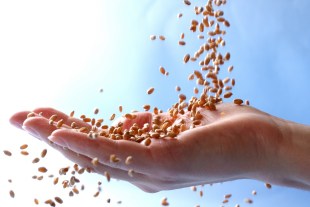You have all heard of fiber, the mainly undigested bits in non-animal foods. You know us nutrition folk worship the stuff because it keeps you and me regular, slows down your eating, slows down digestion and it keeps your intestines healthy. If your bowels are happy, then the whole world seems much more friendly and ordered.
The fiber travels past your stomach and small intestines, and slides into the large intestine teeming with super-helpful and enthusiastic bacteria. These bacteria just love fiber. They will eat fiber all day, reproductively divide with big smiles, while producing compounds that kills bowel cancer cells.
OK, heard all that before; what about resistant starch?
Well, for a long time we thought that fiber was pretty much the only thing in food that did the job of making our waste wholesome, soft and bulky. Now we know that resistant starch (RS) is having a similar effect. It is not really fiber as we know it, although, like fiber, it doesn’t get digested and so the RS ends up in the large intestine. That is, RS is resistant to digestion.
Sometimes RS is called a “prebiotic” because it is used as a food source by the bacteria, much like inulin, a long chain of fructose molecules, which is often added to foods claiming to have “prebiotics”. Inulin occurs naturally in foods like asparagus, garlic, artichokes, bananas, leeks, onions, wheat, barley and rye. Don’t confuse prebiotics with probiotics, a topic I shall chat about in the next edition.
What food has resistant starch?
Foods with high levels of RS include unprocessed whole grains, legumes, green bananas, and cooled, cooked potato (think potato salad). As a banana ripens the (long chain) starch begins to form (short chain) sugars making it sweeter and the RS levels decline. Despite that, about 85% of the remaining banana starch eaten makes it to the appendix where the large intestine begins. That’s why both ends of your digestive system love bananas.
Also, clever folk have been able to selectively breed grains to have a higher resistant starch content. In Australia, you may have seen bread with “High Maize” added; it’s a type of corn with naturally high levels of resistant starch. The “High Maize” starch is added to the bread to increase the fiber content.
Why would starch be resistant to digestion?
First know this – RS is composed of long chains of glucose. Indeed, that’s what all starches are – very long chains of glucose. Some chains are branched and some are straight. It is the long straight chains that are most likely to resist digestion.
Anyway, here are three common reasons why some starch is RS:
1) Some starch just plain can’t be reached by digestive enzymes during the trip through the intestine; it’s not there long enough for an enzyme to reach it. Happens with whole seeds and whole grains;
2) the starch is mainly in the form of long straight chains of glucose; enzymes can only break off the end glucose and again they haven’t enough time to get to the middle of the chain e.g starch in the banana; and
3) when starch cools after cooking it can form gelatinized starch which outwits the enzymes e.g. potato salad.
What does it all mean?
Note that all the sources of RS mentioned are whole foods. When a starch gets processed (e.g refined flour) it usually takes a beating and starts breaking up. Those long chains become short chains and short chains are dead easy to digest so no starch gets through to the large intestine (which annoys the bacteria there, let me tell you. They really look forward to a feed of RS. Bought something on eBay and not arrive? Times that by 100 and that’s how annoyed they get).
There is much more to the story than I can quickly relate. For example, there are three different types of RS and they are involved in more than just bowel health – they probably help control fluctuations in blood glucose making RS a great diabetes buster.
The message, I believe, is that here is another reason to eat mainly minimally processed foods because they offer bio-active compounds and benefits that you can’t simply replicate by heavily processing natural foods, chucking in some nutrients, then trying to pass it off as close to the original.
If I can put it in music terms: this weekend is the five day Elvis Festival in Parkes, New South Wales where highly processed Elvis impersonators number more than the residents. It is great fun, but for the rest of the year you want to listen the unprocessed original.
Last Reviewed 02/Mar/2014
Editor
Latest posts by Editor (see all)
- Oily fish and diabetes prevention - 04/06/20
- Manage the andropause - 11/12/17
- Testing testosterone levels - 07/12/17
